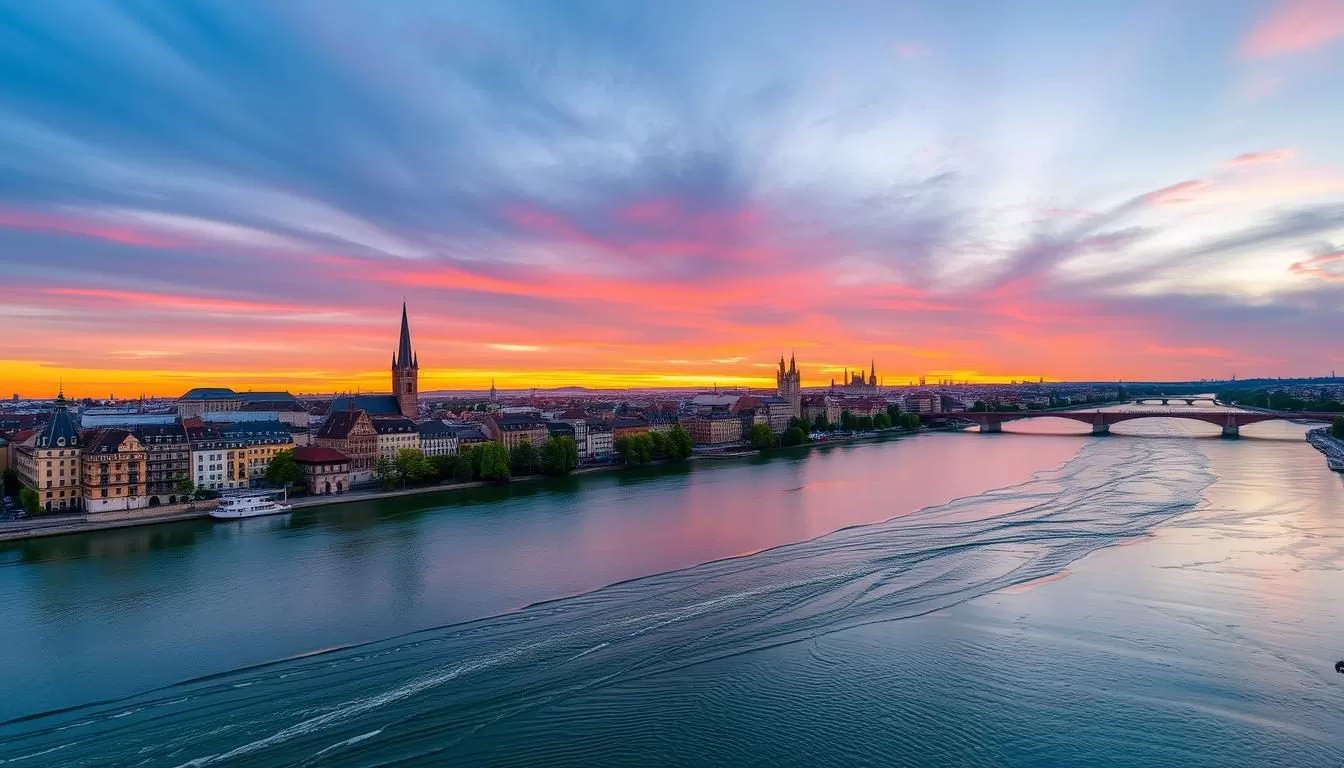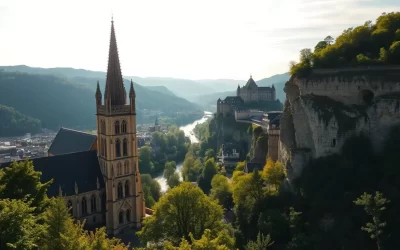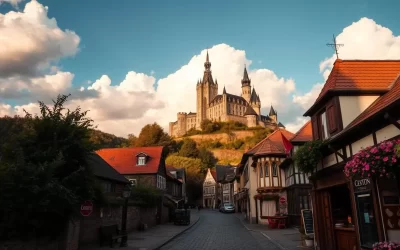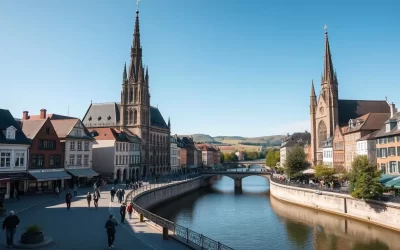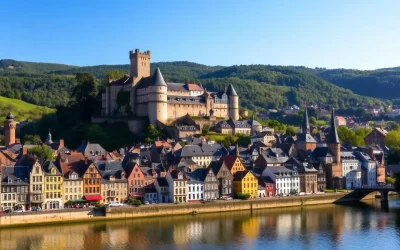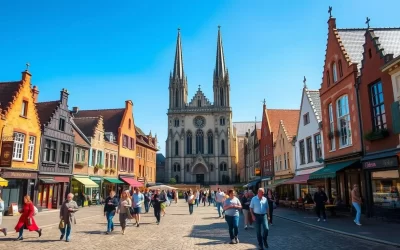Tucked away in Belgium, Liège is a treasure trove of history, culture, and delicious food waiting to be explored. Like many travelers, you might not have considered Liège as your next destination, but this city has a lot to offer, from its historic architecture to its vibrant cultural scene.
Explore the Best of Liège
This comprehensive guide will take you through the best things to do in Liège, including climbing the famous Montagne de Bueren, sampling local delicacies, and exploring the city’s most impressive landmarks and secret alleys.
Liège offers a perfect blend of historical significance, cultural attractions, and unique experiences, making it an ideal destination for a weekend getaway. Whether you’re planning a day trip or a longer stay, this guide will help you make the most of your time in this charming Belgian city.
Throughout this article, you’ll discover our carefully curated list of places to visit in Liège, showcasing why this city deserves more attention from travelers seeking authentic European experiences.
Discovering Liège: Belgium’s Hidden Gem
Tucked away in the heart of Europe, Liège is a treasure waiting to be uncovered. As you explore this vibrant city, you’ll discover a rich history, cultural landmarks, and a unique blend of traditional and modern attractions.
A Brief History of Liège
Liège, located in the Wallonia region of Belgium on the Meuse river, has a storied past that spans centuries. The city’s strategic location has played a significant role in shaping its history, from prehistoric settlements to its growth as a major industrial center.
The murder of St. Lambert in 705 marked a turning point in Liège’s development, leading to a period of growth and prosperity. Over the centuries, Liège experienced dramatic transformations, becoming an important cultural and economic hub. Despite facing decline in the late 20th century, the city is now experiencing a renaissance, blending its historical heritage with modern developments.
| Period | Event | Impact on Liège |
|---|---|---|
| Prehistoric times | Initial settlements | Foundation of the city |
| 8th century | Murder of St. Lambert | Growth and prosperity |
| Late 20th century | Industrial decline | Economic challenges |
| Present day | Renaissance and modernization | Revitalized city with a blend of old and new |
Why Liège Deserves Your Attention
Liège is an ideal time to experience the best of Belgium. The city’s multicultural character is reflected in its many names across various languages, highlighting its position at the crossroads of European cultures. As you visit Liège, you’ll find that its rich history, cultural attractions, and modern developments make it a compelling destination.
The city’s heart city charm is evident in its vibrant atmosphere, with a mix of historical landmarks, cultural events, and traditional cuisine. Whether you’re interested in exploring the city’s industrial heritage, enjoying local specialties like Liège waffles, or simply soaking up the atmosphere, Liège has something to offer.
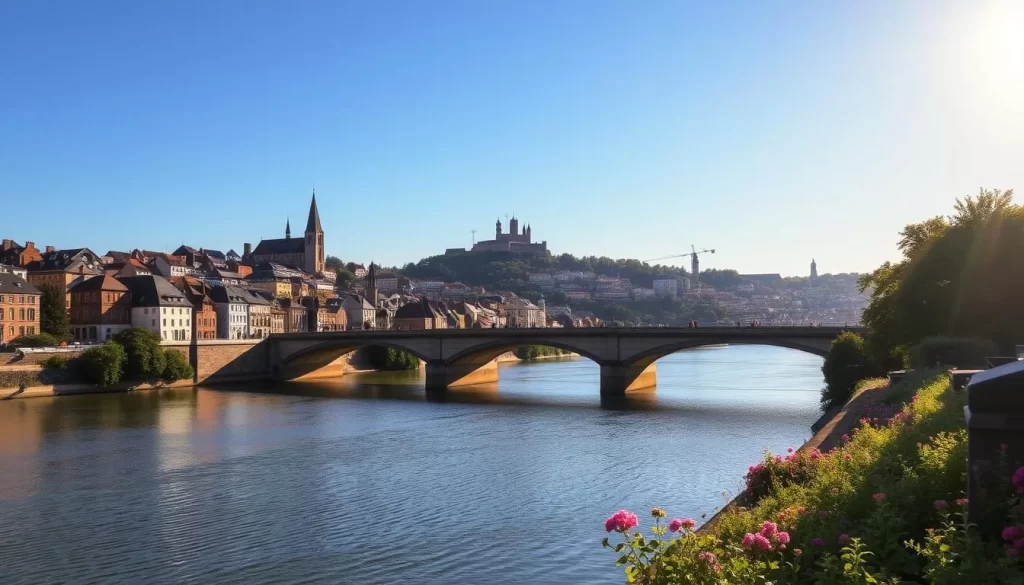
As you plan your trip, consider the many attractions and experiences that Liège has to offer. From its historic churches and religious sites to its modern cultural attractions, Liège is a city that will captivate and inspire you.
How to Get to Liège
Getting to Liège is easier than you think, with multiple transportation options available. Whether you’re traveling from within Europe or from further afield, Liège’s strategic location makes it accessible by various means.
By Train
Traveling to Liège by train is arguably the most convenient way to reach the city, with its impressive Liège-Guillemins station serving as a major hub for both domestic and international rail services. You can take the Eurostar to Brussels Midi and then connect to a train to Liège, with the entire journey taking approximately 3-4 hours depending on connection times. If you’re coming from neighboring countries, Liège is well-connected by high-speed trains, including Thalys and ICE services, making it easily accessible from Paris, Amsterdam, Cologne, and other major European cities.
I took the train as this was the easiest option. I booked a ticket on the Eurostar from St Pancras in London, which left at just after 9 am, and got in to Brussels Midi 2 hours later. My connecting train to Liège-Guillemins station didn’t leave for another 1½ hours, which gave me enough time to grab lunch and have a quick look around the shops. The journey from Brussels Midi to Liège took another 45 minutes, and I arrived just after 2 pm. I was impressed by the train journey – the train itself was comfortable and clean, and arrived on time.
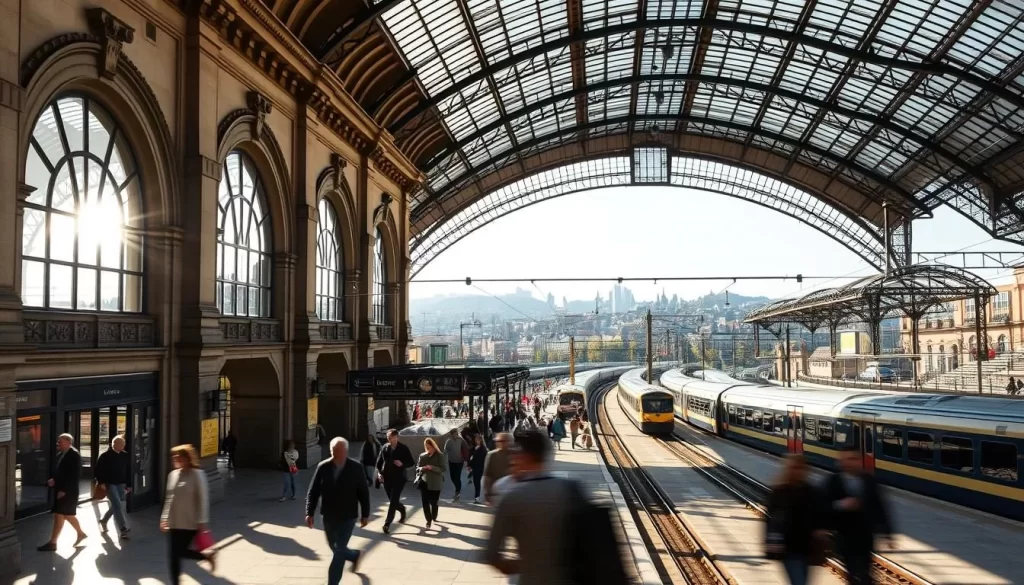
By Bus
Bus services like Flixbus offer budget-friendly options to reach Liège, with direct connections from many European cities at competitive prices (as low as €9 from Cologne). While it may take longer than traveling by train, it’s a viable alternative for those on a tight budget or preferring to travel by bus.
By Car
Driving to Liège is straightforward thanks to Belgium’s excellent highway network. However, be prepared for typical European city parking challenges once you arrive. If you’re driving, you can use Google Maps to navigate your way to Liège. The journey can take around 1 hour or more depending on traffic conditions.
Getting Around Liège
You can easily move around Liège using its comprehensive transportation network. The city is designed to be navigable, with various options to suit different preferences and needs.
Public Transportation Options
Liège’s public transportation system is efficient and reliable, making it easy to explore the city. The bus network is extensive, with routes 1 and 48 being particularly useful as they connect the train station to the historic centre. You can catch these buses directly outside the Liège-Guillemins station, and they will take you right into the heart of the city. A one-way ticket costs €2.60 per person, and you pay the driver directly with cash.
The buses are frequent, clean, and well-maintained, making them the best way to get around. The main bus stops in the centre are located just outside the opera house and at the Place de la République Française.
- Route 1 and 48 buses connect the train station to the historic centre.
- Tickets cost €2.60 per ride and are purchased directly from the driver.
- Buses are frequent and well-maintained.
La Navette Fluviale: The River Shuttle
For a unique perspective on the city, consider taking La Navette Fluviale, the river shuttle that operates along the river Meuse. This shuttle service includes stops at key locations such as the historic centre, the aquarium, and near Guillemins station, offering a relaxing way to see Liège’s landmarks.
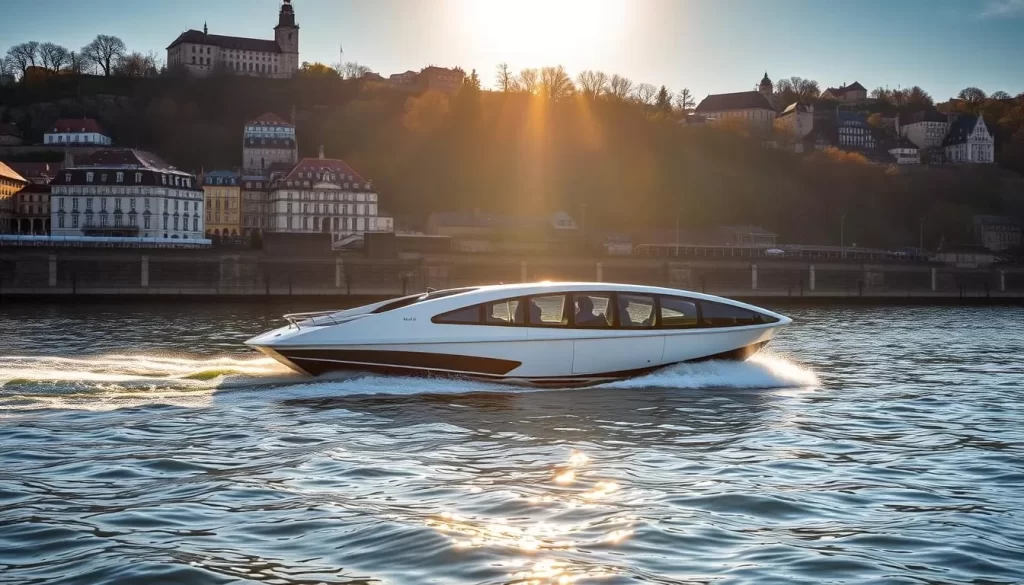
Walking in Liège
Walking is an excellent way to explore Liège’s compact historic centre. While the cobblestone streets can be uneven and some areas have steep inclines, the city’s layout makes it relatively easy to navigate on foot. You can enjoy the city’s architecture, discover hidden gems, and experience the local culture firsthand.
By combining these transportation options, you can easily explore Liège and enjoy all that the city has to offer.
Best Time to Visit Liège
Liège offers a unique experience in every season, making it essential to choose the best time for your visit. The city’s charm is evident throughout the year, but certain times are more ideal for specific activities and experiences.
Seasonal Highlights
Liège can be visited year-round, with each season bringing its own attractions and experiences. Spring (April-June) is characterized by mild temperatures and blooming flowers, making it an ideal time for exploring the city’s outdoor spaces and hillside walks without the peak tourist crowds.
In summer (July-August), Liège is at its warmest, and you might catch special events like Bueren en Fleurs, where the famous staircase is adorned with colorful flowers. This is peak tourist season, so expect more visitors.
Fall brings spectacular foliage, and on the first Saturday of October, the city hosts Nocturne des Coteaux de la Citadelle, where thousands of candles illuminate the Montagne de Bueren stairs. Although this event is cancelled for 2023, it’s worth checking the city’s event calendar for future visits.
Winter transforms Liège with Christmas markets and a festive atmosphere. While it’s the coldest season, it’s perfect for enjoying the city’s cozy side, though you should be prepared for shorter daylight hours.
| Season | Highlights | Weather |
|---|---|---|
| Spring (April-June) | Mild temperatures, blooming flowers, outdoor explorations | Mild |
| Summer (July-August) | Warmest weather, Bueren en Fleurs, peak tourist season | Warm |
| Fall | Spectacular foliage, Nocturne des Coteaux de la Citadelle | Cool |
| Winter | Christmas markets, festive atmosphere | Cold |
Local Events and Festivals
Liège hosts various events throughout the year, adding to its charm. If you’re visiting in the summer, you might witness Bueren en Fleurs. In the fall, the Nocturne des Coteaux de la Citadelle is a magical experience, although it’s worth checking if it’s scheduled for the year you’re visiting.
For the most up-to-date information on local events and festivals, it’s a good idea to check the city’s official tourism website or local event calendars to plan your trip accordingly.
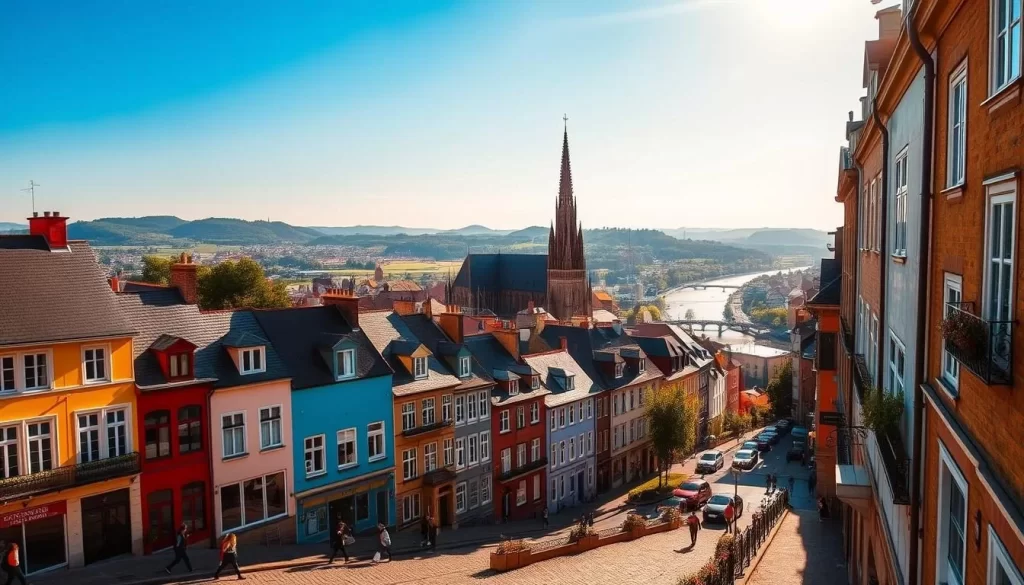
Liège-Guillemins Railway Station: An Architectural Marvel
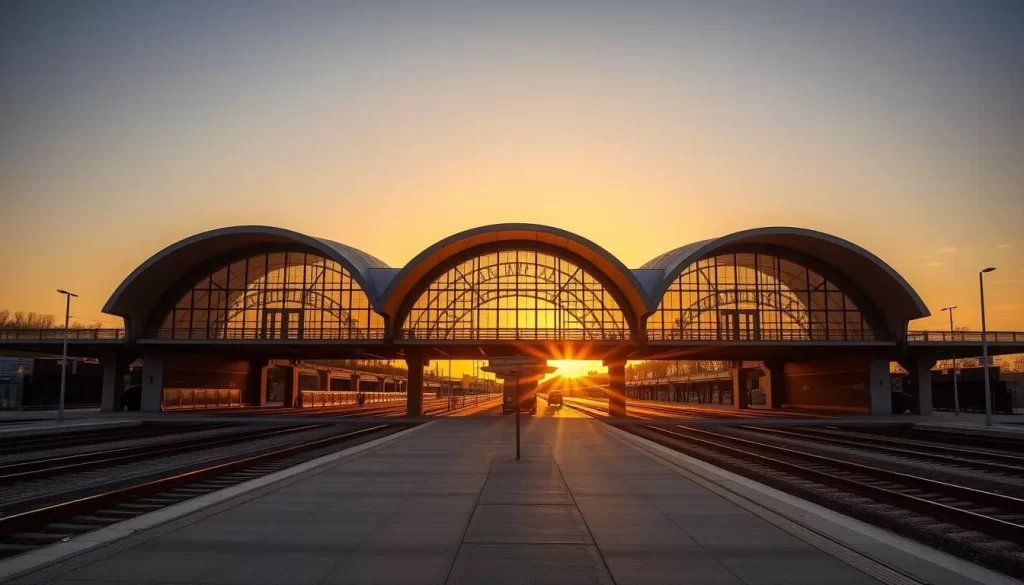
As you step into Liège, one of the first things that will strike you is the Liège-Guillemins Railway Station, a masterpiece designed by Santiago Calatrava. This train station is not just a transportation hub; it’s an architectural marvel that has put Liège on the map for travelers and architecture enthusiasts alike.
The Design by Santiago Calatrava
The Liège-Guillemins Railway Station was designed by the renowned Spanish architect Santiago Calatrava and completed in 2009. Calatrava’s signature style is evident in the station’s sweeping white arches and impressive skeletal structure, creating a cathedral-like atmosphere that is both breathtaking and humbling. The design bears a striking resemblance to Calatrava’s other famous works, such as the World Trade Center Transportation Hub in New York and the City of Arts and Sciences in Valencia.
Photography Tips and Best Viewing Times
For photography enthusiasts, the Liège-Guillemins Railway Station offers endless opportunities to capture stunning photos. The best times to visit for photography are during the early morning or late afternoon when the sunlight filters through the massive glass and steel canopy, creating dramatic shadows and highlights. Occasionally, the station hosts special art installations, such as Daniel Buren’s colorful illuminations, which add an extra layer of beauty to this already spectacular building.
To make the most of your visit, consider the following tips:
– Visit during the golden hour for the best lighting conditions.
– Explore the surrounding areas to capture the station from different angles.
– Look out for special events or exhibitions that might be happening during your visit.
Climbing the Famous Montagne de Bueren
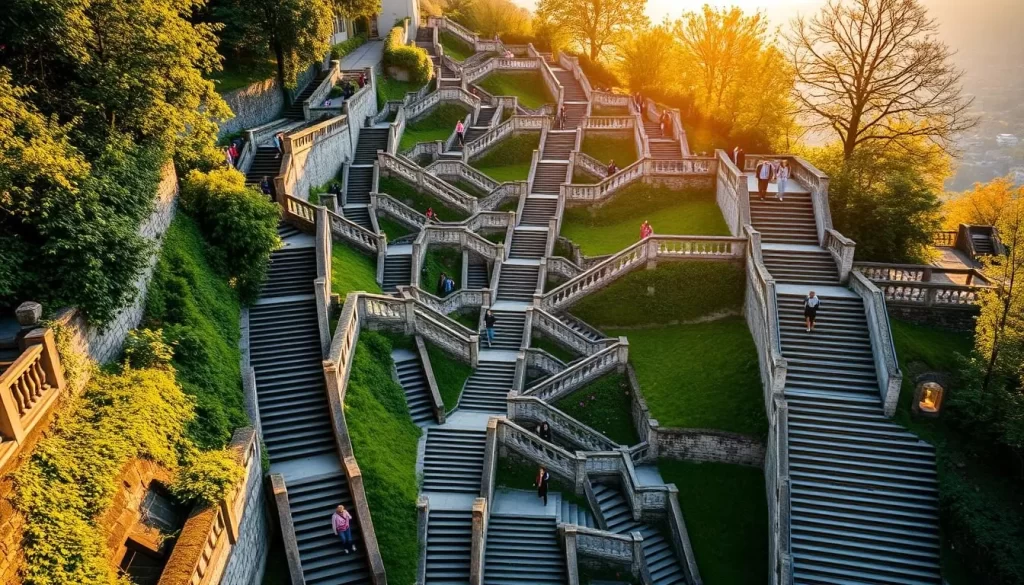
If you’re looking for a unique experience, the 374 steps of Montagne de Bueren await. This iconic staircase is not just a physical challenge but a journey through history, offering breathtaking views of Liège and the Meuse River.
The History Behind the 374 Steps
The Montagne de Bueren staircase was built in 1881 to commemorate the 600 soldiers who died trying to defeat the Duke of Burgundy in the 15th century. This monumental staircase links the town center to the citadel, providing a historical and cultural significance that goes beyond its physical challenge.
As you climb, you’ll notice the staircase is lined with residential houses, a unique aspect that sets it apart from other monumental stairs. Locals navigate these steps daily, and visitors are asked to be respectful of the residents.
What to Expect During Your Climb
As you begin your ascent up the 374 steps, you’ll be struck by the imposing structure of the staircase. The climb can be challenging, but the sense of achievement you’ll feel when you reach the top is rewarding.
During your climb, take a moment to appreciate the surrounding architecture and the daily life of the locals who call this staircase a part of their daily route.
The Breathtaking Views from the Top
Once you reach the top of the Montagne de Bueren, you’ll be rewarded with panoramic views of the city of Liège and the Meuse River valley. The citadel and a peaceful park are also within walking distance, offering a serene conclusion to your climb.
Take a moment to catch your breath and enjoy the views. The experience is not just about the climb but also about the historical and cultural significance of the area.
In conclusion, climbing the Montagne de Bueren is a must-do activity when visiting Liège. It’s a unique blend of history, culture, and physical challenge that offers something for everyone.
Exploring the Citadel and Its Hillsides
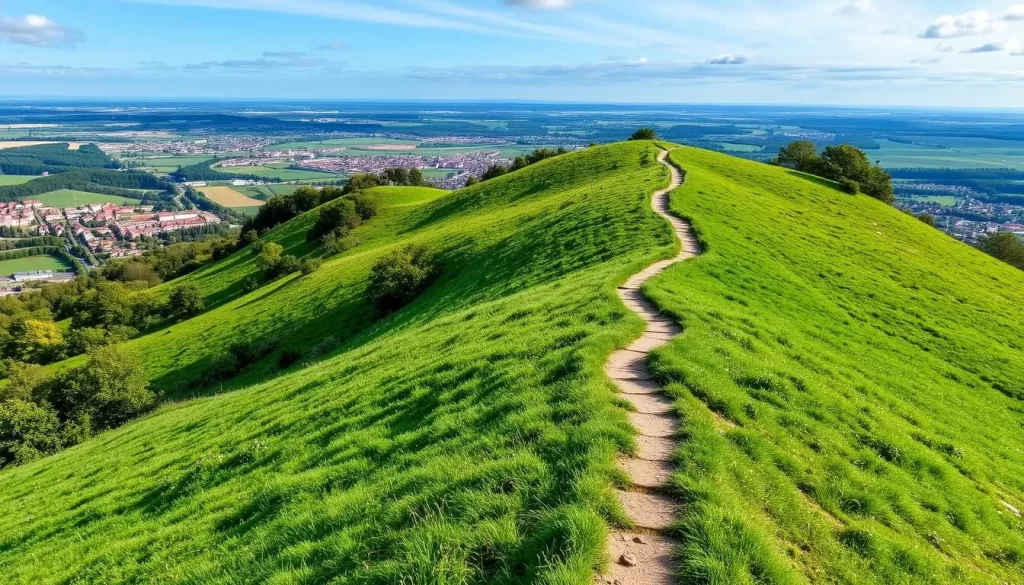
As you wander through Liège, the Citadel’s hillsides beckon, promising a journey through time and nature. This historic site, nestled in the heart of the city, offers a serene escape from the bustling streets below. The Citadel is not just a place of historical significance but also a haven for those seeking a peaceful walk amidst lush greenery.
The Waymarked Trails
The Citadel features four waymarked trails that cater to different preferences and fitness levels. One of these trails leads you through an almost jungle-like path, a surprising contrast to the urban landscape you’re just a step away from. As you explore these trails, you’ll discover the rich history of the Citadel, including remnants of its past fortifications and the innovative use of the land over centuries.
These trails are not just paths; they’re journeys through layers of history, from medieval times when the area was used for growing medicinal plants, vineyards, and culinary herbs, to its current state as a preserved historical site. The categorization and recognition by the Michelin guide underscore the significance and quality of these trails.
The Monument au 14ème Régiment de Ligne
As you explore the Citadel, you’ll come across the Monument au 14ème Régiment de Ligne, a solemn reminder of Belgium’s complex history and the sacrifices made during the Second World War. This monument honors the soldiers of the 14th Line Regiment, adding a layer of historical depth to your visit.
The monument stands as a poignant spot for reflection, amidst the natural beauty and historical ruins that surround it.
Best Photo Spots
The terraces of the Citadel are among the best photo spots in Liège, offering panoramic views of the city and the Meuse River. The contrast between the red brick ruins and the lush greenery creates a visually appealing backdrop for any photos. As you capture the beauty of Liège from this vantage point, you’ll appreciate why the Citadel is a cherished landmark.
For those looking to explore beyond the famous Montagne de Bueren stairs, the Citadel and its hillsides provide a comprehensive and enriching experience, combining history, nature, and breathtaking views of the city.
The Secret Alleys of Liège: Impasses
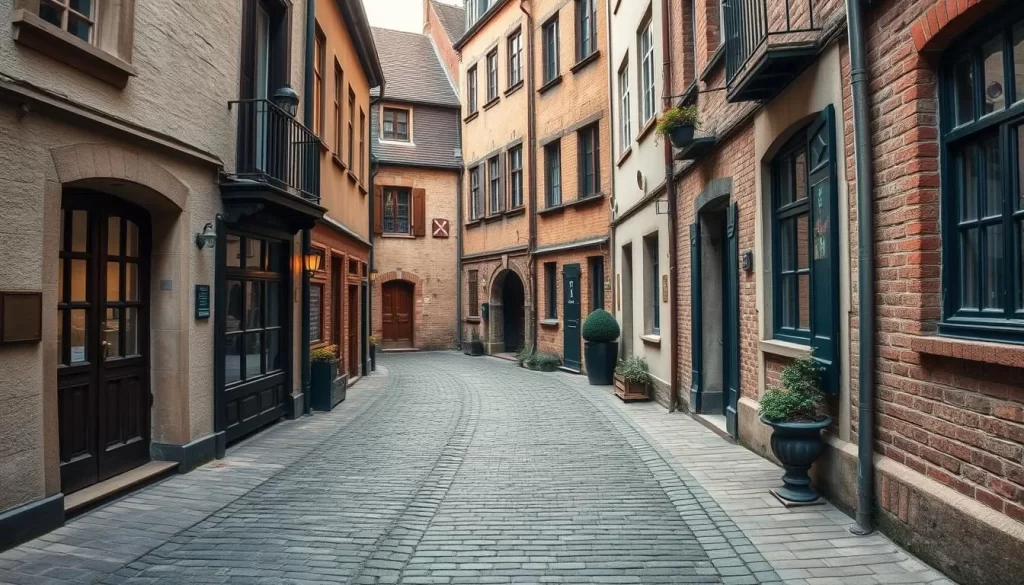
Liège’s ancient heart beats strongest in its secret alleys, waiting to be discovered by curious travelers. Just off the busy Rue Hors-Château, one of Liège’s oldest streets, lies a network of hidden alleys called “impasses” that transport you back in time to medieval Liège.
These charming impasses are characterized by narrow, cobblestone pathways lined with historic houses. As you explore these hidden gems, you’ll feel as though you’ve stepped into a different era, far removed from the hustle and bustle of modern city life.
Impasse des Ursulines
Impasse des Ursulines stands out as particularly charming, named after the convent at one end and featuring a secret passage through what appears to be someone’s door. This unique passage leads to the beautiful Terrasses des Minimes park, offering a serene escape from the city.
Impasse de l’Ange and Impasse Venta
Impasse de l’Ange and Impasse Venta offer romantic, narrow cobblestone pathways that feel frozen in time, with historic houses and charming courtyards that make you forget you’re in the center of a modern city.
Rue Hors-Château and Its Hidden Treasures
The busy Rue Hors-Château is more than just a street; it’s a gateway to the hidden treasures of Liège’s impasses. As you explore these narrow alleys, you’ll discover charming courtyards, historic architecture, and a glimpse into the city’s rich past.
As you explore these hidden alleys, remember to be respectful of the private residences and keep noise levels down. With their unique charm and historic significance, Liège’s impasses are a must-visit destination for anyone looking to experience the authentic character of this Belgian city.
Delicious Local Specialties to Try in Liège
Belgium is renowned for its waffles, but few know that Liège has its own unique twist. When visiting Liège, you should definitely try the local specialties that make this city stand out. From sweet treats to savory delights, Liège offers a culinary experience that is both authentic and mouth-watering.
Liège Waffles: A Sweet Tradition
Liège waffles, or Gaufres de Liège, are a must-try when in the city. Unlike the more commonly known Brussels waffles, Liège waffles are made from a thicker dough containing chunks of sugar that caramelize during cooking, giving them a crunchy, golden exterior. You can enjoy them plain or with various toppings, but they’re delicious on their own.
For the best Liège waffles, visit Une Gaufrette Saperlipopette near the Palace of the Prince Bishops, where locals often line up for these freshly made treats. Alternatively, try Pollux near the cathedral for simple yet delicious options. If you’re looking for variety, La Gaufrerie on Rue des Dominicains offers both Liège and Brussels-style waffles with numerous toppings.
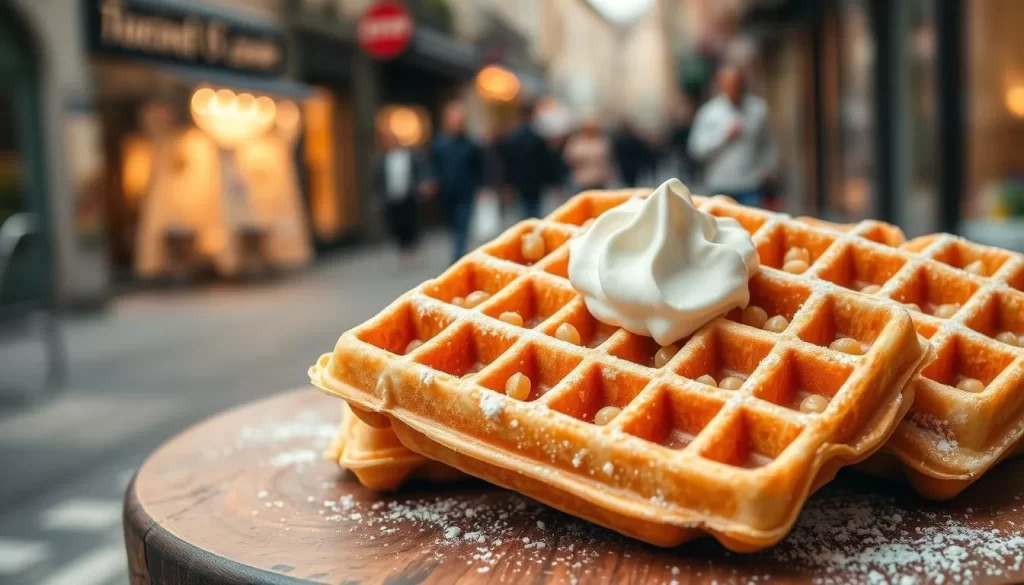
- Liège waffles are a local specialty with a thicker dough and caramelized sugar.
- Try them at Une Gaufrette Saperlipopette, Pollux, or La Gaufrerie.
- Enjoy them plain or with your choice of toppings.
Belgian Beer: Curtius and Beyond
Belgium is famous for its beer, and Liège is no exception. Curtius, a local brewery, produces exceptional craft beers that you can sample at their microbrewery, Brasserie C, or at various bars throughout the city. Belgian beer enthusiasts will find Liège to be a haven for exploring different brews.
Boulets à la Liégeoise: Traditional Meatballs
Another local specialty is Boulets à la Liégeoise, traditional meatballs made from a mixture of beef and pork, served in a sweet-sour sauce made with sirop de Liège, a local apple and pear syrup. For an authentic version, head to Amon Nanesse restaurant.
Best Places to Eat in Liège
Liège offers a range of dining options to suit all tastes. For vegetarians, Como n Casa provides sit-down meals, while Green Burger is great for quick bites. Whether you’re in the mood for something traditional or innovative, Liège has a place for you to enjoy local cuisine at the right time.
In conclusion, Liège is a city that will surprise you with its culinary delights. Be sure to try the local specialties during your visit and explore the various shops and eateries that make Liège a gastronomic hub.
Sunday at La Batte Market: Europe’s Oldest Market
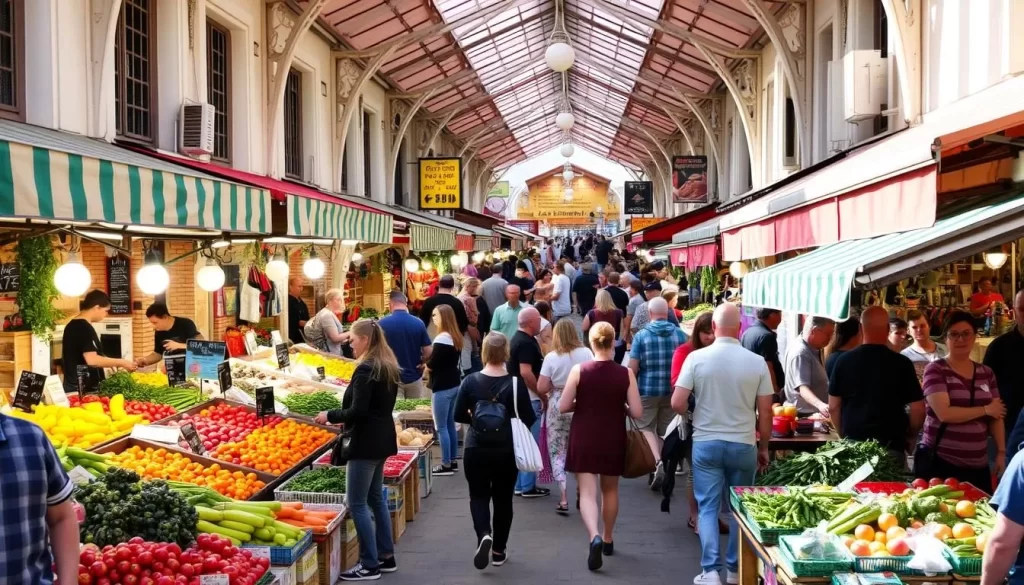
La Batte market, held every Sunday in Liège, is a must-visit destination for anyone looking to experience the authentic heart of the city. This historic market stretches for almost 3 kilometers along the banks of the Meuse River, offering an eclectic mix of stalls selling everything from local produce to clothing and unusual pets.
The market is a treasure trove of local specialties, including artisanal cheeses, fresh meats, and traditional Belgian waffles. You can also find a variety of household items and unique souvenirs to take back home. Whether you’re looking for something to eat, a special gift, or just a fun day out, La Batte market has something for everyone.
What to Find at the Market
The La Batte market is renowned for its diverse range of products. You can browse through stalls selling fresh produce, including fruits and vegetables, as well as artisanal foods like cheeses and baked goods. The market also features a selection of clothing stalls, offering everything from casual wear to more formal attire. Additionally, you can find unique items such as handmade crafts and antiques.
One of the highlights of the market is its food stalls, offering a variety of traditional Belgian cuisine. You can sample local delicacies like Boulets à la Liégeoise (Liège-style meatballs) or enjoy a freshly made waffle. The market also includes vendors selling a range of beverages, from coffee and tea to Belgian beer.
Tips for Visiting
To make the most of your visit to La Batte market, it’s recommended to arrive early, between 8-10 am, to avoid the crowds and have the best selection of goods. The market operates from 8 am to 2 pm, although some sources suggest it may run until 4:30 pm. Be sure to bring cash, as not all vendors may accept credit or debit cards.
Visiting La Batte market is not just about shopping; it’s an immersive experience into local culture. Take your time to explore the various stalls, engage with the vendors, and enjoy the lively atmosphere. It’s also a great opportunity to practice your French and soak up the unique ambiance of this historic market.
Historic Churches and Religious Sites
Liège’s historic churches and religious sites are a testament to its rich history. As you wander through the city, you’ll discover a plethora of religious buildings that have stood the test of time, each with its own unique story to tell.
Saint Paul’s Cathedral
Saint Paul’s Cathedral, or Cathédrale Saint-Paul de Liège, is one of the city’s most impressive religious buildings. Originally constructed in the 10th century and rebuilt between the 13th and 15th centuries, it stands as a significant historical landmark in the heart of the old town. You can easily spend an hour or so exploring the cathedral, admiring its statues, stained-glass windows, and impressive naves.
The cathedral’s interior is particularly striking, featuring pristine black and white marble floors that resemble a large chess board. The vibrant stained-glass windows blend traditional and modern artistic styles, creating a breathtaking visual experience. As you explore, you’ll find that the cathedral offers multilingual information about its history and artistic elements, making it accessible to international visitors.
Saint-Barthélemy Church and Its Baptismal Font
Another significant religious site in Liège is the Saint-Barthélemy Church, renowned for housing one of Belgium’s official “Seven Wonders” – its 12th-century baptismal font. This masterpiece of Mosan goldsmithery represents the pinnacle of medieval craftsmanship and is a must-see when visiting the city.
The baptismal font is an extraordinary example of the artistic and religious heritage of Liège. As you take the time to appreciate its intricate details, you’ll gain a deeper understanding of the city’s cultural and historical significance.
Other Notable Religious Buildings
In addition to Saint Paul’s Cathedral and Saint-Barthélemy Church, Liège is home to several other notable religious buildings. The Collegiate Church of Saint-Jacques, with its flamboyant Gothic architecture, and the Church of Saint Servatius are just a few examples. Each of these churches offers unique architectural elements and historical significance, making them worth a visit during your time in the city.
As you explore these religious sites, you’ll not only be admiring beautiful buildings but also experiencing the rich cultural and spiritual heritage that Liège has to offer.
Underground Liège: The Archéoforum
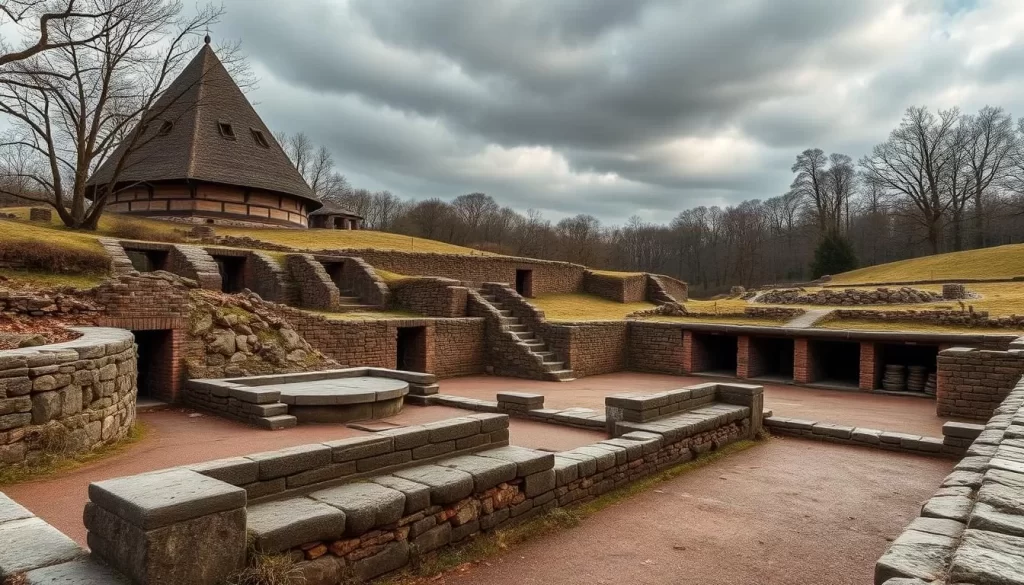
The Archéoforum is an archaeological gem that reveals the multilayered history of Liège, hidden beneath Place Saint-Lambert. As you explore this vast underground site, you’ll uncover the remnants of various settlements that date back to prehistoric times, through the Roman era, and into the Middle Ages.
Walking Through Centuries of History
As you walk through the Archéoforum, you’ll be struck by the sheer scale and complexity of Liège’s history. The site spans over 3,000 square meters and features the remains of a Roman villa, complete with thermal baths, as well as the foundations of the medieval Cathedral of Saint-Lambert, which was demolished during the French Revolution. The self-guided tour is enhanced by free interactive tablets that provide detailed information about each area, along with physical models and digital recreations that help visualize how these structures appeared in their time.
The Archéoforum offers a unique journey through Liège’s history, allowing you to explore the city’s development from ancient times to the present day. You’ll be able to see the remains of prehistoric settlements, Gallo-Roman villas, and medieval structures, all in one place. This is a truly immersive experience that brings the history of Liège to life.
Practical Information for Visitors
The Archéoforum is located directly under Place Saint-Lambert, in the heart of Liège’s city centre. It’s open Tuesday through Friday from 9am to 4pm and Saturdays from 10am to 5pm. Be sure to note that the site is closed on Sundays, so plan your visit accordingly. Tickets cost €6, and you can find more information on the official website or by checking Google Maps for the most up-to-date opening hours and ticket prices.
To make the most of your visit, consider picking up the free interactive tablet guide, which provides additional insights and information about the exhibits. This will enhance your understanding and appreciation of the historical significance of the Archéoforum, making your visit even more enjoyable and informative.
Museums and Cultural Attractions in Liège
As you explore Liège, you’ll discover a city that’s deeply rooted in its history and culture, with museums being a significant part of its identity. The city boasts an impressive array of museums that cater to diverse interests, from natural history and fine arts to local culture and industrial heritage.
Discovering the Aquarium-Museum
The Aquarium-Museum is one of the best places to visit in Liège with kids. This three-floor museum is divided into different sections, including a Natural History section on the top floor, a temporary exhibition space on the ground floor, and an Aquarium on the underground floor. The Natural History section features various skeletons and stuffed animals, including an impressive adult blue whale skeleton. The Aquarium showcases a variety of fish species, making it an educational and engaging destination for families.
La Boverie Fine Arts Museum
La Boverie Fine Arts Museum is housed in a beautiful building within Boverie Park. It showcases both permanent collections of fine art and rotating international exhibitions in partnership with major institutions like the Louvre. The museum’s diverse collection makes it a must-visit for art enthusiasts.
Exploring Le Grand Curtius
Le Grand Curtius is a striking red mansion that brings together five formerly separate museums into one comprehensive collection. The museum spans archaeology, religious art, decorative arts, weaponry, and glass making, offering visitors a rich cultural experience.
Museum of Walloon Life
The Museum of Walloon Life provides fascinating insights into the region’s cultural heritage, traditions, and everyday life through the centuries. The museum features interactive exhibits that appeal to visitors of all ages, making it an ideal destination for families and history enthusiasts.
Some of the other notable museums in Liège include the Museum of Religious Art & Mosan Art, Trinkhall museum (MADmusée), and the Museum of Public Transport in Wallonia. Each of these museums offers a unique perspective on the city’s history, art, and culture.
- Liège boasts an impressive array of museums that cater to diverse interests.
- The Aquarium-Museum is an ideal destination for families with children.
- La Boverie Fine Arts Museum showcases both permanent collections and rotating international exhibitions.
- Le Grand Curtius offers a comprehensive collection spanning various disciplines.
- The Museum of Walloon Life provides insights into the region’s cultural heritage and traditions.
Exploring the Meuse River
The Meuse River winds its way through Liège, providing both scenic beauty and practical transportation options. As you explore the city, you’ll find that the river is an integral part of its charm and character.
River Cruises and the Navette Fluviale
One of the most relaxing ways to experience Liège is by taking a cruise along the Meuse River. La Navette Fluviale, a regular river shuttle, operates in a loop from the historic center down to Fragnée, stopping at several points along the way. You can hop on or off at your preferred stop, including the one directly outside the aquarium and the one near Guillemins train station.
The journey takes about 45 minutes from one end to the other, and you can purchase tickets on board. The prices are very reasonable, with options to pay per stop or buy a day pass for €8. However, note that the shuttle doesn’t run on Mondays and is closed during the winter months.
The Pont de Fragnée and Other Historic Bridges
A little further south than Guillemins station lies the Pont de Fragnée, a beautiful Parisian-style bridge that spans the Meuse River. Built for the 1905 Universal Exhibition, this bridge took four years to construct and is decorated with gilt sculptures, including one of Medusa. The bridge also features four tall columns topped with golden statues of angels playing trumpets.
The Pont de Fragnée is easily accessible by the river shuttle, which stops just next to the bridge, or by bus lines that stop nearby. While it’s a bit further from the historic center, it’s definitely worth a visit.
Outremeuse Island and Parc de la Boverie
You might not realize it at first, but a significant portion of Liège is actually situated on an island in the Meuse River, known as Outremeuse. Connected by many bridges, it doesn’t initially feel like an island. However, standing on the bridges and looking out over the river reveals the island’s charm.
Outremeuse is home to several attractions, including the Fine Arts Museum (Beaux Arts Musee, BAM) and Parc de la Boverie, located at the southern tip of the island. Parc de la Boverie offers a peaceful green retreat from the urban environment, with beautiful gardens, walking paths, and the La Boverie museum of fine arts.
Street Art and Modern Culture in Liège, Belgium: Best Things to Do – Top Picks
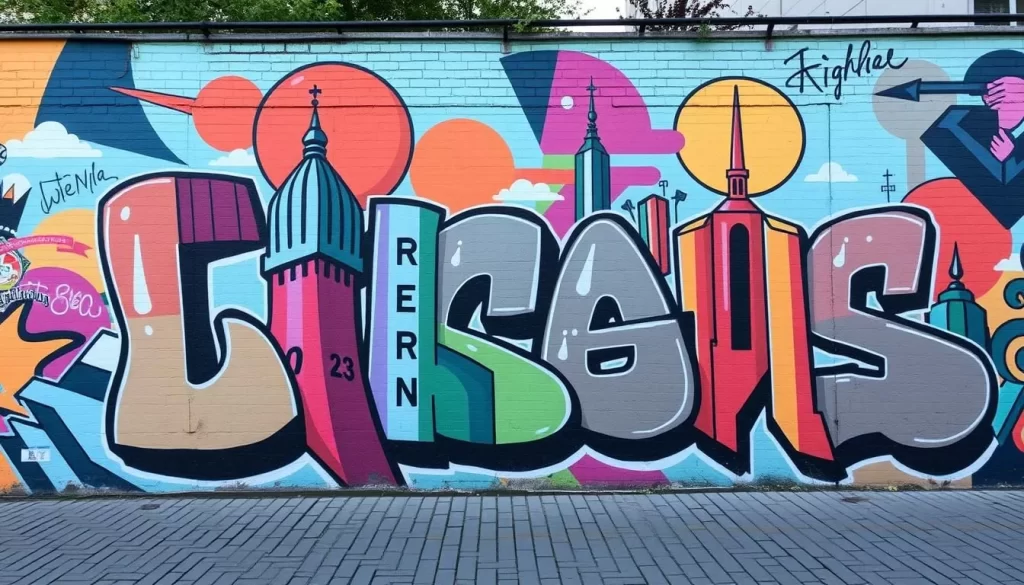
As you wander through Liège, you’ll discover a vibrant street art scene that adds a splash of color to the city’s historic landscape. The city’s street art is not just an afterthought; it’s a deliberate blend of modern culture with the historic architecture that Liège is known for.
The most striking example of Liège’s street art is the enormous mural covering the facade of the former Fine Arts Museum building. This building is a perfect starting point for any street art enthusiast visiting Liège.
Finding the Best Murals
To explore Liège’s street art, start by visiting the Saint-Léonard neighborhood and the areas along the Meuse River, where you’ll find an impressive collection of large-scale murals by both local and international artists. The city’s street art map, available at the tourism office or online, is a valuable resource for navigating the best murals and installations.
Using this map, you can create your own self-guided tour of Liège’s urban art scene, ensuring you don’t miss any of the city’s hidden gems.
Cultural Hotspots for Art Lovers
Liège is not just about street art; it’s also home to several cultural hotspots that art lovers will appreciate. Le Pot au Lait, a hip bar with an artistic atmosphere, and the Trinkhall Museum, focused on outsider art, are just a couple of the city’s cultural attractions. Independent galleries throughout the city also showcase a wide range of contemporary art.
These cultural hotspots, combined with the city’s vibrant street art scene, make Liège a unique destination for anyone interested in modern culture and art.
Where to Stay in Liège
Liège’s accommodation options cater to various preferences and budgets, ensuring a comfortable stay in the heart of the city or nearby. Whether you’re looking for luxury, convenience, or budget-friendliness, Liège has a diverse range of hotels, hostels, and B&Bs to choose from.
Accommodations in the Historic Center
For those who want to be in the midst of Liège’s charm, staying in the historic centre is ideal. Hotels like Hotel Neuvice, housed in a beautifully renovated old building, offer not only a prime location but also character and charm. Being within walking distance to major attractions, restaurants, and shops enhances your experience, making every day in Liège convenient and enjoyable.
The Van der Valk Hotel Sélys Liège is another excellent choice, known for its comfortable rooms and spacious bathrooms with underfloor heating – a luxury on a cold day. Its location is just a short walk from the city centre, making it perfect for those who want to explore Liège on foot.
Budget-Friendly Options
For travelers on a budget, Liège offers several affordable accommodations without compromising on comfort or location. Youthhostel Liège and various Airbnb options in charming historic buildings throughout the city provide good value. When choosing your accommodation, consider your transportation needs – staying near Liège-Guillemins station is convenient for day trips, while the historic center is better for exploring Liège itself.
Whether you’re looking to splurge or save, Liège’s accommodation options ensure that you find a hotel that suits your needs, making your stay as enjoyable as possible.
Planning Your Perfect Trip to Liège
Liège, a hidden gem in Belgium, is waiting to be explored, and with the right itinerary, you can make the most of your visit. Whether you’re planning a day trip or a weekend getaway, organizing your schedule around the city’s top attractions will help you experience the best of Liège.
For a one-day visit, focus on the heart of the city with a morning climb up the Montagne de Bueren stairs, followed by exploring the Liège Citadel and its hillsides. Spend your afternoon visiting Saint-Barthélemy Church and the Archéoforum before ending with photos at the architectural marvel of Liège-Guillemins train station.
If you’re traveling with kids, consider adding the Aquarium-Museum to your list, which offers three floors of exhibits, including natural history displays and an impressive collection of aquatic life that kids will love. A weekend in Liège allows you to explore at a more relaxed pace and add day trips to nearby attractions like the Val Saint Lambert Cristal Discovery, Préhistomuseum, or Blegny Mine (a UNESCO World Heritage site).
Don’t forget to leave time in your schedule for culinary experiences – sampling Liège waffles at Une Gaufrette Saperlipopette, enjoying local beer at Brasserie C, and trying traditional boulets à la Liégeoise should all be on your list of things to do. Use Google Maps to save all the places you want to visit, as many of Liège’s hidden gems, like the impasses (secret alleys), can be difficult to locate without navigation assistance.
By planning your trip according to your interests and making the most of your time, you’ll be able to experience the best that Liège has to offer. With its rich history, cultural attractions, and delicious cuisine, Liège is a destination that promises an unforgettable experience.
The above is subject to change.
Check back often to TRAVEL.COM for the latest travel tips and deals.
